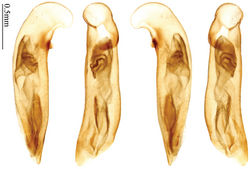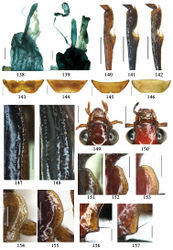Anchista pilosa
| Notice: | This page is derived from the original publication listed below, whose author(s) should always be credited. Further contributors may edit and improve the content of this page and, consequently, need to be credited as well (see page history). Any assessment of factual correctness requires a careful review of the original article as well as of subsequent contributions.
If you are uncertain whether your planned contribution is correct or not, we suggest that you use the associated discussion page instead of editing the page directly. This page should be cited as follows (rationale):
Citation formats to copy and paste
BibTeX: @article{Shi2013ZooKeys284, RIS/ Endnote: TY - JOUR Wikipedia/ Citizendium: <ref name="Shi2013ZooKeys284">{{Citation See also the citation download page at the journal. |
Ordo: Coleoptera
Familia: Carabidae
Genus: Anchista
Name
Anchista pilosa Shi & Liang sp. n. – Wikispecies link – ZooBank link – Pensoft Profile
Type material
Holotype (MNHN): male, body length = 7.8 mm, board mounted, genitalia dissected and deposited in microvial pinned under specimen, “Bangalore / Chikkangalur / Tabourel 1900”; “MUSEUM PARIS / 1952 / COLL. R. OBERTHÜR”; “HOLOTYPE ♂/ Anchista pilosa / new species / Des. SHI H. L. 2011” [red label][Figs 43, 74, 98].
Diagnosis
Pronotum pubescent, lateral margins hardly angulate near middle, sinuate before hind angles; elytra with bicolored pattern; elytra pubescent, primary setigerous pores not distinct; elytral basal margination extended only to 3rd interval; median lobe of aedeagus without setae around apical orifice.
Based on pubescent surface and elytral pattern, the new species resembles the subspecies Anchista fenestrata subpubescens Chaudoir, but can be distinguished in having the following characters: (1) elytral basal margination extended only to 3rd interval, but in Anchista fenestrata subpubescens basal margination nearly complete; (2) pronotum with lateral margins less angulate and hind angles less distinct in the new species; (3) males with tarsi adhesive hairs well developed (two whole rows) on first three mesotarsomeres, but in Anchista fenestrata subpubescens adhesive hairs rudimentary (weakly present near apex) on first three mesotarsomeres in males; (4) males of the new species with terminal sternum more deeply emarginate than in Anchista fenestrata subpubescens; (5) median lobe of aedeagus without setae around apical orifice, but in Anchista fenestrata subpubescens median lobe of aedeagus with long setae around apical orifice.
Description
Body length 7.8 mm; dorsum yellow to reddish yellow, pronotum lateral explanate areas pale yellow; 1st antennomere yellow, remaining antennomeres reddish brown. Elytra bicolored, forming faint pattern, background nearly brownish, with lateral part slightly paler; large yellow patch occupying inner five intervals from base to apical third; lateral margins and epipleura yellow. Ventral side yellow, sterna darker toward apex; femora and tibiae yellowish, tarsi yellowish brown. Head sparsely pubescent, nearly glabrous on front, without microsculpture or punctures. Pronotum with disc pubescent, rather sparser along median line, nearly glabrous on lateral explanate areas;pronotumcordiform, widest slightly before middle; ratio PW/PL 1.53; pronotal base briefly but distinctly lobed; disc moderately convex, microsculpture indistinct, without punctures; front angles with few moderately long setae; lateral margins hardly angulate in middle, strongly sinuate before hind angles; lateral explanate areas wide and even; hind angles slightly obtuse, with few accessory setae; basal foveae moderately deep, with few punctures; median line indistinct, slightly depressed subbasally. Elytra with striae shallow, distinct, slightly punctate along striae; intervals slightly convex, with dense and regular accessory setae; microsculpture indistinct; primary setigerous pores on 3rd and 5th intervals hardly visible, five pores on 3rd interval, two on the 5th; basal margination extended only to 3rd interval. Males with adhesive hairs well developed (two whole rows) on first three mesotarsomeres; males with terminal sternum more deeply emarginate than other members of the genus (as in Fig. 145), but less deeply than in Paraphaea (Fig. 143). Male genitalia with median lobe of aedeagus straight and flat, gently expanded to apex; left lateral margin slightly curved in middle; apical orifice opened dorsally, margin around apical orifice not setose; apical lamella placed on right side, flat and rounded, width subequal to length in dorsal view, not curved upwards dorsally in lateral view; internal sac with two moderately sclerotized flagella near apical orifice, internal sac irregularly scaled and sclerotized, basal part more distinctly sclerotized (Fig. 74). Female genitalia unknown.
Distribution
(Map 3). Only known from type locality Bangalore (India).
Etymology
The name “pilosa” comes from Latin, meaning pubescent, referring to the pubescent surface of this species.
Remarks
Based on median lobe of aedeagus without setae, elytral basal margination incomplete and male terminal sternum more deeply emarginate than other species, the new species seems to be isolated in the genus. But, male genital internal sac characters and distribution of male adhesive hairs on tarsi indicated that this species is a member of Anchista.
Original Description
- Shi, H; Zhou, H; Liang, H; 2013: Taxonomic synopsis of the subtribe Physoderina (Coleoptera, Carabidae, Lebiini), with species revisions of eight genera ZooKeys, 284: 1-129. doi
Images
|
![Figures 43–48. Type materials, scale bars = 2.0 mm: 43 Holotype of Anchista pilosa sp. n. 44 Holotype of Metallanchista laticollis sp. n. 45 Holotype of Diamella kaszabi Jedlička [= Diamella kaszabi (Jedlička)] 46 Lectotype of Calleida cupreomicans Oberthür [= Diamella cupreomicans (Oberthür)] 47 Lectotype of Allocota aerata Bates [= Diamella cupreomicans (Oberthür)] 48 Holotype of Lachnoderma arrowi Jedlička [= Diamella arrowi (Jedlička)].](https://species-id.net/o/thumb.php?f=ZooKeys-284-001-g008.jpg&width=237)



